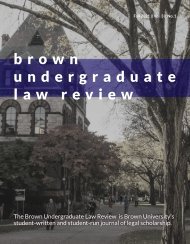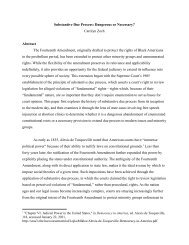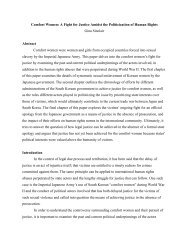Brown Undergraduate Law Review — Vol. 2 No. 2 (Spring 2021)
We are proud to present the Spring 2021 issue of the Brown Undergraduate Law Review. We hope that the works contained herein offer insight and inspiration to all who read them.
We are proud to present the Spring 2021 issue of the Brown Undergraduate Law Review. We hope that the works contained herein offer insight and inspiration to all who read them.
You also want an ePaper? Increase the reach of your titles
YUMPU automatically turns print PDFs into web optimized ePapers that Google loves.
The Legal Precedents for Police Brutality: The Enduring Legacy of the Objective Reasonableness Standard<br />
Cases regarding 42 U.S.C. Section 1983 are also governed<br />
by another concept: qualified immunity. The doctrine of<br />
qualified immunity was originally established by Pierson<br />
v. Ray (1967), in which police in Jackson, Mississippi,<br />
arrested a group of clergymen, including three black<br />
priests, after the group attempted to use a racially<br />
segregated bus terminal. 6 This arrest was based on a state<br />
code that outlawed congregating with others in a public<br />
place, breaching the peace, and refusing to move when<br />
ordered by a police officer. The clergymen were later<br />
sentenced to jail by a local judge. They filed suit against<br />
both the police department and judge under Section 1983<br />
on the basis of false arrest and imprisonment. The Court of<br />
Appeals for the Fifth Circuit maintained that the judge was<br />
immune from liability based on prior Supreme Court<br />
precedent (Bradley v. Fisher (1871)). 7 With regards to the<br />
police, the appeals court found the Mississippi code<br />
unconstitutional yet determined that the police officers had<br />
not acted wrongfully since the police had no way of<br />
knowing which laws were unconstitutional when arresting<br />
the clergymen.<br />
Upon hearing the case, the Supreme Court agreed that the<br />
judge was immune from liability but clarified that the<br />
police officers were not entitled to absolute immunity.<br />
Rather, officers were entitled to immunity when acting<br />
under laws they reasonably believed to be constitutional<br />
even if said laws are later determined otherwise:<br />
A policeman's lot is not so unhappy that he must<br />
choose between being charged with dereliction of duty<br />
if he does not arrest when he has probable cause, and<br />
being mulcted in damages if he does. Although the<br />
matter is not entirely free from doubt, the same<br />
consideration would seem to require excusing him<br />
from liability for acting under a statute that he<br />
reasonably believed to be valid but that was later held<br />
unconstitutional, on its face or as applied . . . . We hold<br />
that the defense of good faith and probable cause,<br />
which the Court of Appeals found available to the<br />
officers in the common-law action for false arrest and<br />
imprisonment, is also available to them under Section<br />
1983. 8<br />
The Supreme Court finally remanded the case for retrial<br />
given evidence that racial motivations influenced the jury.<br />
In the process, the Court?s ruling established the doctrine<br />
of qualified immunity for police officers under Section<br />
1983.<br />
The first major Supreme Court case relating Section 1983<br />
to the authoritative use of force was Tennessee v. Garner<br />
(1985). 9 On October 3, 1974, Memphis Police Officers<br />
Elton Hymon and Leslie Wright responded to reports of a<br />
home break-in. 10 Hymon explored behind the house and<br />
heard a door slam. He then saw 15-year-old Edward<br />
Garner run across the backyard. Using a flashlight, Hymon<br />
was able to see Garner's face and hands and was<br />
?reasonably sure? that Garner was unarmed. He called out<br />
for Garner to halt but Garner began to climb over a<br />
chain-link fence. Then, Hymon fatally shot Garner in the<br />
back of the head. His decision to shoot was based on a<br />
Tennessee statute and police department policy stating that<br />
if, ?after notice of the intention to arrest the defendant, he<br />
either flees or forcibly resists, the officer may use all the<br />
necessary means to effect the arrest.? 11 The authorities<br />
later found ten dollars and a purse on Garner?s body.<br />
Though Hymon suspected Garner of burglarizing the<br />
house, he did not have proof at the time of the shooting.<br />
Garner?s father filed suit under 42 U.S.C. Section 1983,<br />
alleging violations of his son's rights under the Fourth,<br />
Fifth, Sixth, Eighth, and Fourteenth Amendments. The<br />
district court ruled in favor of the defendants since Hymon<br />
was acting under state and local policy. However, the Sixth<br />
Circuit Court of Appeals reversed the judgment and held<br />
that killing is a form of ?seizure.? The court determined<br />
7. Ibid.<br />
8. Ibid.<br />
9. Brandon Garrett and Seth Stoughton, ?A Tactical Fourth Amendment,? Virginia <strong>Law</strong> <strong>Review</strong> 103, no. 2 (April 2017): 224.<br />
10. Tennessee v. Garner, 471 U.S. 1 (1985).<br />
11. Ibid., 471 U.S. 3.<br />
<strong>Brown</strong> <strong>Undergraduate</strong> <strong>Law</strong> <strong>Review</strong><br />
48










